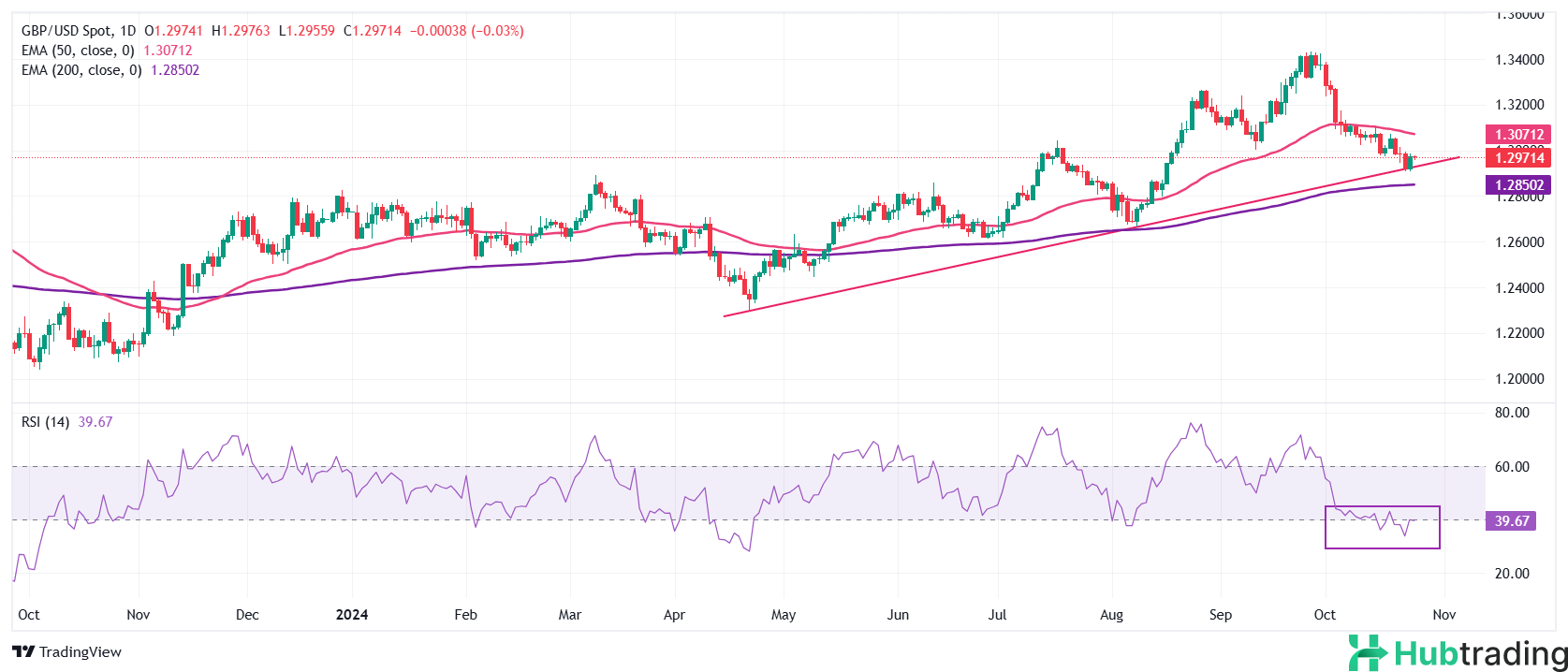- The Pound Sterling consolidates after a slight recovery on Thursday, following remarks from BoE’s Mann, who emphasized that services inflation must decrease further before additional rate cuts can be considered.
- The UK flash PMI report indicates that while business activity expanded in October, it did so at a slower rate.
- Traders appear to be increasingly wagering on a Donald Trump victory in the upcoming US presidential election.
The Pound Sterling (GBP) continues to climb, approaching the psychological resistance level of 1.3000 against the US Dollar (USD) during Friday’s New York session. The GBP/USD pair is gaining ground as the US Dollar experiences a correction following the release of the September Durable Goods Orders data. The US Dollar Index (DXY), which measures the Greenback’s value against six major currencies, is testing levels below 104.00. While new orders for core goods contracted at a steady rate of 0.8% in September, this decline was less than the anticipated 1.0%, indicating a stable market for durable goods.
Overall, the outlook for the US Dollar remains positive as traders increasingly factor in the possibility of former President Donald Trump winning the upcoming presidential election on November 5. Many in the market view this scenario as favorable for the Dollar, anticipating higher tariffs and lower taxes under a Trump administration, which could negatively affect currencies from trading partners. However, Standard Chartered warns of a potential sharp repricing of the Dollar if current Vice President Kamala Harris secures victory in the elections.
Speculation is also growing that the Federal Reserve (Fed) will adopt a gradual approach to interest rate cuts, which could limit any significant correction in the Dollar. According to the CME FedWatch tool, the Fed is expected to implement further interest rate cuts in November and December at a standard pace of 25 basis points (bps), following a 50-bps cut that initiated its easing cycle in September.
Investors are particularly focused on the upcoming Durable Goods Orders report, set to be released at 12:30 GMT, with economists forecasting a 1% decline after flat figures in August.
Market Movers: Pound Sterling Outperforms Major Peers
- The Pound Sterling maintains its recovery against major peers on Friday, although it is poised to record its fourth consecutive week of losses against the US Dollar. Nevertheless, the near-term outlook for the British currency appears brighter, supported by several factors: hawkish comments from Bank of England (BoE) Monetary Policy Committee member Catherine Mann and ongoing expansion in economic activity, as indicated by the flash UK S&P Global/CIPS Purchasing Managers Index (PMI) data for October.
- During a panel discussion at the International Monetary Fund (IMF) meetings, Catherine Mann, a known hawk, acknowledged the recent soft inflation figures for September but stressed the necessity for further declines. Despite service inflation falling below 5%, Mann highlighted that it has yet to align with the BoE’s target of 2%.
- Regarding her stance on interest rates, Mann stated, “It would be premature to cut rates if you have structural persistence in the relationship between wages and price formation.” Despite her hawkish comments, traders continue to speculate that the BoE may reduce interest rates further in November.
- Additionally, Thursday’s preliminary PMI report revealed that business activity in the UK expanded in both the manufacturing and service sectors, albeit at a slower pace than in September. While growth was slower than projected, it still outperformed that of the US and Eurozone, where manufacturing output continues to contract.
Technical Analysis: Pound Sterling Aims to Surpass 1.3000

The Pound Sterling is trading near 1.3000 against the US Dollar, maintaining momentum from Thursday’s rebound after finding buying interest near the lower boundary of a Rising Channel formation around 1.2900 on the daily timeframe.
The near-term trend for the GBP/USD remains uncertain as it trades below the 50-day Exponential Moving Average (EMA) around 1.3070. The 14-day Relative Strength Index (RSI) is below 40.00, indicating ongoing bearish momentum.
Looking ahead, the 200-day EMA near 1.2845 represents a significant support level for Pound Sterling bulls. On the upside, resistance is anticipated near the 20-day EMA around 1.3060.





